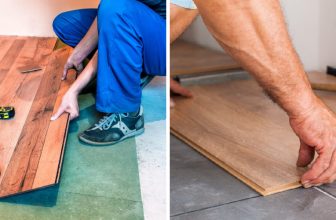How to Measure Floor Registers
Do you need to replace a floor register? Or you’re installing a brand-new one. Whatever the case, measurements are key for ensuring your new (or existing) register fits in properly with the rest of your home aesthetic and provides just the right airflow. Taking precise measurements is easy when you have the right tools.
Whether you’re a DIY enthusiast or a professional, this guide will help you accurately measure floor registers in just a few simple steps.

In this blog post, we’ll discuss how to measure floor registers and effectively choose replacement parts that fit perfectly into any space. So, if you’ve ever needed clarification on measuring your registers correctly, read on and learn all about it!
What Will You Need?
Before diving into the process, let’s ensure you have all the necessary tools for measuring your floor registers. Here is what you’ll need:
- Measuring tape
- Pencil or pen
- Paper or notepad (or a smartphone to take notes)
Now that you have everything ready let’s get started!
10 Easy Steps on How to Measure Floor Registers
Step 1: Identify the Register
Start by identifying the register you want to measure. It could be an existing one needing replacement or a new location where you plan to install a register. Ensure the area around the register is clean and clear of any obstructions for accurate measurements. If you’re replacing an old register, remove it from its place and set it aside.
Step 2: Measure the Width
Using your measuring tape, measure the width of the opening where the register will be installed. If there is an existing register in place, measure the actual size of it to ensure you get a perfect fit for the replacement. If there isn’t any register in place, measure the width of the opening from one side to the other.
Step 3: Measure the Length
Next, measure the length of the opening. This is the distance from the front of the hole to the back. Place the tape measure’s end at the opening’s front edge, and extend it to the rear edge. Note down the measurement to ensure a correct fit for your register. Just like the width, if there is an existing register, measure the actual size of it. If there’s no register, measure the opening length from front to back.

Step 4: Double Check Your Measurements
After you’ve taken the width and length measurements, it’s important to double-check them to ensure accuracy. Mistakes in measurement can lead to improper fits that can affect your home’s ventilation system. Repeat the measuring process and compare the measurements. If they match, you’re good to go. If not, re-measure until you’re confident in your dimensions.
Step 5: Checking the Depth
The depth of the register refers to how far it goes into the floor. While measuring the depth for certain types of registers isn’t always necessary, it’s a good idea to check, especially if your floor has thick carpeting or padding. Place the end of your tape measure at the top edge of the opening and extend it to the bottom to measure the depth. Record this measurement. Be sure to do this carefully as a deeper or shallower register can affect the overall airflow.
Step 6: Select the Right Replacement
With your measurements in hand, you’re now ready to select an appropriate replacement register. When choosing your register, it’s important to remember that the size of the register is typically larger than the size of the duct opening. For example, if your duct opening is 10 inches by 4 inches, you would typically need a register that measures 11.5 inches by 5.5 inches. Check the manufacturer’s specifications and ensure the register size you pick suits your duct opening.
Step 7: Test the Fit
Once you’ve purchased your new register, test it by fitting it into the duct opening. If it fits snugly and flush against the floor, you’ve done a great job of measuring and choosing the correct product. If it doesn’t fit, recheck your measurements and return the register if necessary.
Step 8: Secure the Register
After confirming the register fits, secure it in place. Most floor registers simply drop into the opening and require no additional securing. However, some models may have screw holes for added security. If this is the case, use a drill or screwdriver to secure the register to the floor.
Step 9: Check the Airflow
Finally, after the register is securely in place, turn on your HVAC system and check the airflow. The air should flow freely through the register without any blockages. If the air isn’t flowing properly, there might be a problem with the HVAC system, or the register might be incorrectly sized.

Step 10: Clean Up
Once everything is set up correctly, remember to clean up your workspace. Dispose of any old registers or packaging materials appropriately. Keep your tools handy for any future needs. You’ve now successfully measured, selected, and installed a new floor register!
By following these simple steps, you can easily measure floor registers and ensure a perfect fit every time. It’s always better to take accurate measurements and choose the right size register for optimal airflow and aesthetic appeal in your home. So whether it’s a replacement or a new installation, make sure to follow these tips for hassle-free measuring of your floor registers.
5 Additional Tips and Tricks
- Use the Right Tool: A tape measure is typically the most effective when measuring floor registers. It’s flexible enough to handle the corners and contours of the register.
- Measure Both Dimensions: Floor registers are typically rectangular, so measure both the length and the width.
- Take Multiple Measurements: To ensure accuracy, take multiple measurements and use the average as your final measurement.
- Consider the Grille Size: If you’re replacing the register, remember to measure the grille size as well, not just the duct opening.
- Check the Manufacturer’s Specifications: If you still need clarification, checking the manufacturer’s instructions can often provide additional guidance on correctly measuring floor registers. It’s always better to be safe than sorry!
When it comes to home improvement, knowing how to measure floor registers is essential. Whether you’re looking to replace old registers or install new ones, taking accurate measurements is crucial for a proper fit and maximum efficiency.
5 Things You Should Avoid
- Avoid Guessing: Never guess or estimate the measurements. This can lead to purchasing a register that needs to fit properly, wasting time and money.
- Remember the Depth: While length and width are crucial, remember to take into account the depth of the duct. Ignoring this dimension can lead to airflow problems.
- Don’t Rely on Old Measurements: If you’re replacing an old register, don’t assume that the old measurements are still accurate. House structures can shift over time, altering the dimensions of the duct opening.
- Avoid Ignoring the Register’s Design: The design and style of the register can impact airflow. Be aware of this when choosing a replacement.
- Remember the Finish: The finish of the floor register should match the decor of your room. Consider this to avoid a mismatched appearance. Remember, function and aesthetics should go hand in hand when choosing the right floor register for your home.

By avoiding these common mistakes and following the tips outlined in this document, you’ll be well-equipped to measure floor registers accurately and choose the perfect fit for your home.
How Often Should Floor Registers be Replaced?
Floor registers should be replaced every 10-15 years or sooner if visible damage or wear and tear occurs. It’s also a good idea to replace them if you’re making changes to your HVAC system, as this could affect the size and type of register needed for proper airflow. Regular maintenance and cleaning can help prolong the lifespan of your floor registers, but eventually, they will need to be replaced for optimal functionality.
By following these guidelines on measuring and replacing floor registers, you can ensure that your home’s heating and cooling system runs smoothly and efficiently for years to come. Remember to always use the right tools, take accurate measurements, and consider the design and finish of the register for both function and aesthetics. With these tips in mind, you’ll be a pro at measuring floor registers in no time!
Which Register Specifies the Size of the Range?
The supply register typically specifies the range size in an HVAC system. This register is responsible for delivering conditioned air from your HVAC system into each room of your home. Its size is crucial as it determines the volume of air that can be delivered, thus affecting the range and effectiveness of your heating or cooling system. The size of the supply register is usually directly proportional to the size of the ductwork in your home.
Therefore, when measuring your floor registers, pay special attention to the dimensions of your supply register to ensure your HVAC system operates optimally.

Conclusion
After weighing all the considerations, it’s clear how to measure floor registers is an important step to ensure you buy the right size. Not only can a perfect fit improve energy efficiency in your home, but it can also help protect family members from drafts and harm done by incorrectly sized registers. If you’re planning on remodeling or just getting new floor registers, measure accurately before making a purchase.
While this may seem daunting, with the tips we’ve provided throughout this article, you should have no trouble getting the right measurements for your space and finding the best product that meets your needs.
We hope this information has been useful and helps simplify your next register purchase!




